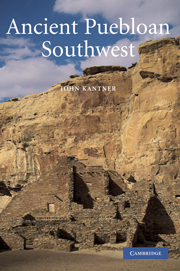Book contents
- Frontmatter
- Contents
- List of figures
- List of boxes
- Acknowledgments
- 1 The ancient Puebloan Southwest: an introduction
- 2 “The Daylight World”: the paleoenvironmental context for Puebloan history
- 3 Return to Ánosin Téhuli? The origins of Puebloan culture
- 4 The wrong Middle Places? Chaco Canyon and the Mimbres Mogollon
- 5 The migrations continue: the end of Chaco and Mimbres
- 6 The AD 1200s: the Great Pueblo period
- 7 The Great Abandonment
- 8 Finding Posi: the protohistoric Puebloan world
- References
- Index
3 - Return to Ánosin Téhuli? The origins of Puebloan culture
Published online by Cambridge University Press: 05 February 2015
- Frontmatter
- Contents
- List of figures
- List of boxes
- Acknowledgments
- 1 The ancient Puebloan Southwest: an introduction
- 2 “The Daylight World”: the paleoenvironmental context for Puebloan history
- 3 Return to Ánosin Téhuli? The origins of Puebloan culture
- 4 The wrong Middle Places? Chaco Canyon and the Mimbres Mogollon
- 5 The migrations continue: the end of Chaco and Mimbres
- 6 The AD 1200s: the Great Pueblo period
- 7 The Great Abandonment
- 8 Finding Posi: the protohistoric Puebloan world
- References
- Index
Summary
The first world, Ánosin Téhuli, was too dark and small. So the Twin Children of the Sun made some grasses grow taller and more robust, creating a ladder upon which all creatures could climb into the second world, K'ólin Téhuli. Populations in K'ólin Téhuli again grew so rapidly that yet a third world, Áwisho Téhuli, was needed, but once again there were too many people. They therefore divided into different tribes, forming distinctions that became most apparent as they ascended into the fourth world, Tépahaian Téhuli. Eventually, the Twins led all the different nations and animals upward toward the light, into the current world, Ték'ohaian Úlahnane, the Daylight World (Cushing 1896).
According to the chimik'yanakona penane, the Zuni origin story, many different groups of people have existed since the beginning of time. Each made a similar journey through successive worlds in which they acted and looked differently, before migrating across the Daylight World and arriving at the spot where they live today. The Zuni accordingly recognize that their current world only makes sense in reference to this past history that shaped them (Ferguson and Hart 1985). In its own way, archaeology tells a very similar story, and its lessons are the same – any given moment in human history is the product of everything that came before. This chapter, then, establishes the foundations for our story of the Puebloan people.
- Type
- Chapter
- Information
- Ancient Puebloan Southwest , pp. 52 - 86Publisher: Cambridge University PressPrint publication year: 2004



